A Research Report on Ethics and Workplace Culture at Philips Finan
VerifiedAdded on 2023/06/05
|11
|2485
|428
Report
AI Summary
This research report delves into the critical aspects of ethics and workplace culture at Philips Financial Services, a full-service independent company. It addresses challenges such as thriving in a competitive market, raising revenue, and cybersecurity, while emphasizing the significance of organizational structure and a positive workplace environment. The report identifies the Adhocracy organizational structure as suitable for Philips Financial Services and underscores the detrimental effects of a negative workplace culture, particularly bullying. Recommendations include declaring bullying unacceptable, defining unacceptable behaviors, establishing clear policies, and creating a credible complaint system. The report concludes that fostering a positive workplace culture through conflict management and employee motivation is crucial for the company's success. Desklib offers this report as a valuable resource for students, alongside a wide range of past papers and solved assignments.
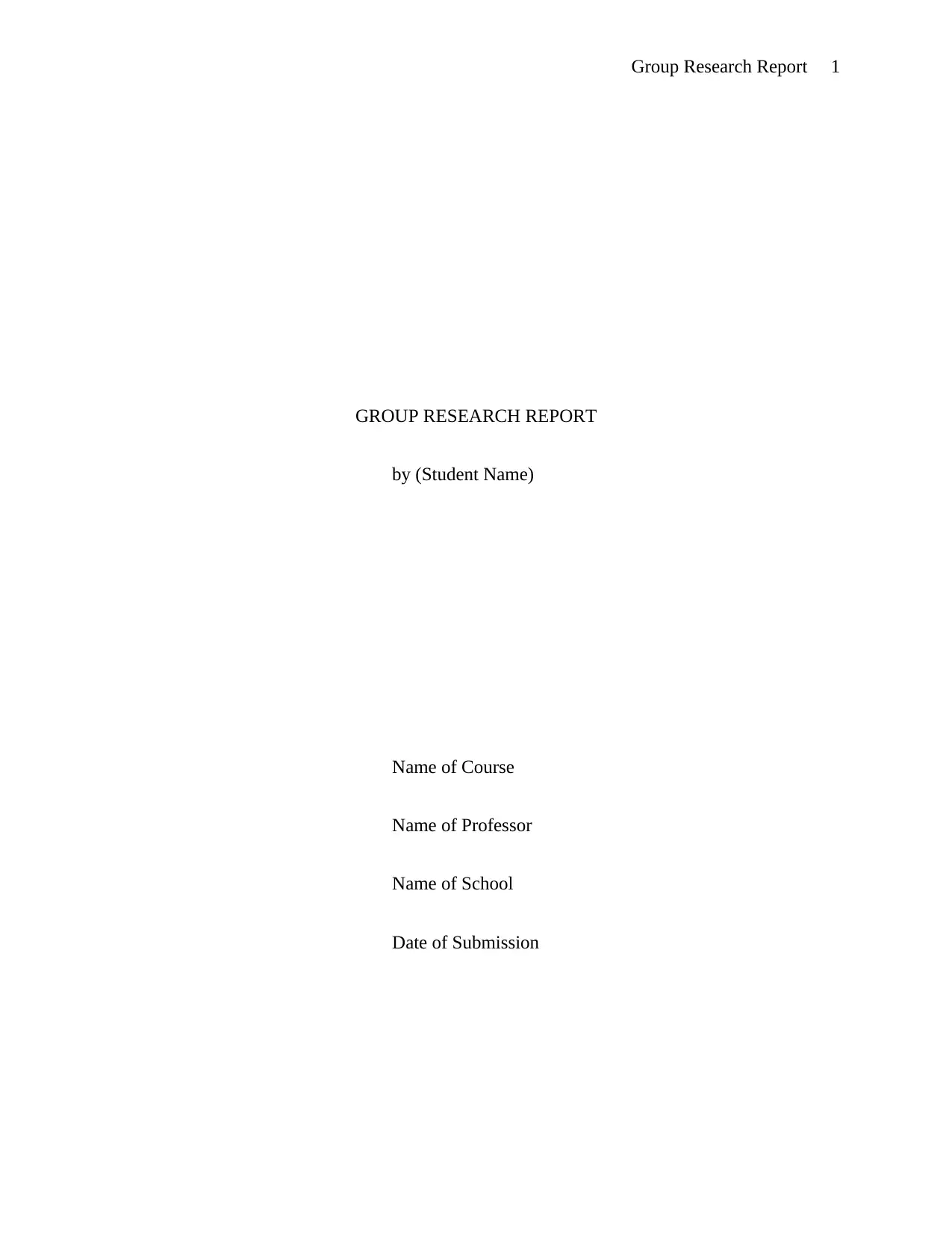
Group Research Report 1
GROUP RESEARCH REPORT
by (Student Name)
Name of Course
Name of Professor
Name of School
Date of Submission
GROUP RESEARCH REPORT
by (Student Name)
Name of Course
Name of Professor
Name of School
Date of Submission
Secure Best Marks with AI Grader
Need help grading? Try our AI Grader for instant feedback on your assignments.
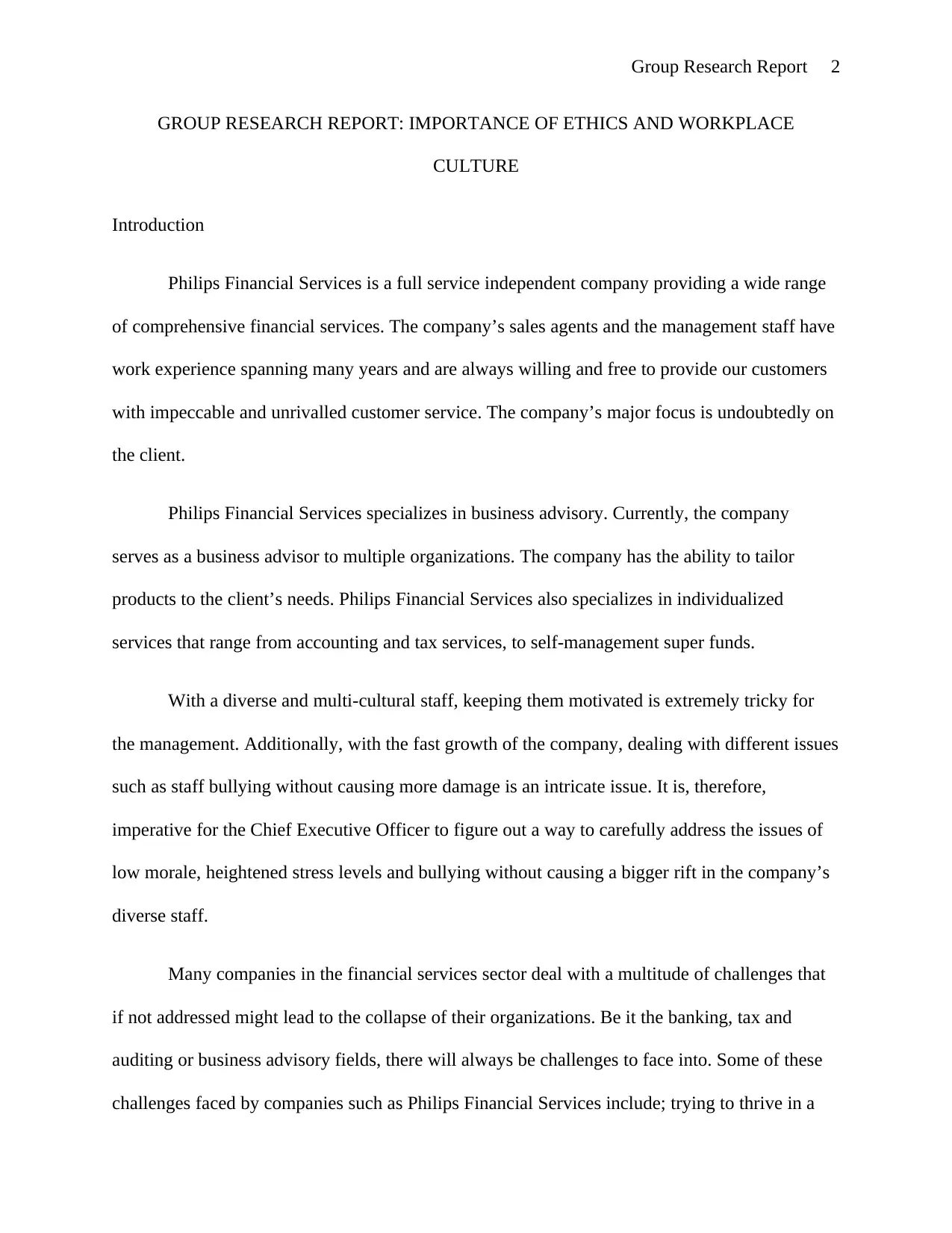
Group Research Report 2
GROUP RESEARCH REPORT: IMPORTANCE OF ETHICS AND WORKPLACE
CULTURE
Introduction
Philips Financial Services is a full service independent company providing a wide range
of comprehensive financial services. The company’s sales agents and the management staff have
work experience spanning many years and are always willing and free to provide our customers
with impeccable and unrivalled customer service. The company’s major focus is undoubtedly on
the client.
Philips Financial Services specializes in business advisory. Currently, the company
serves as a business advisor to multiple organizations. The company has the ability to tailor
products to the client’s needs. Philips Financial Services also specializes in individualized
services that range from accounting and tax services, to self-management super funds.
With a diverse and multi-cultural staff, keeping them motivated is extremely tricky for
the management. Additionally, with the fast growth of the company, dealing with different issues
such as staff bullying without causing more damage is an intricate issue. It is, therefore,
imperative for the Chief Executive Officer to figure out a way to carefully address the issues of
low morale, heightened stress levels and bullying without causing a bigger rift in the company’s
diverse staff.
Many companies in the financial services sector deal with a multitude of challenges that
if not addressed might lead to the collapse of their organizations. Be it the banking, tax and
auditing or business advisory fields, there will always be challenges to face into. Some of these
challenges faced by companies such as Philips Financial Services include; trying to thrive in a
GROUP RESEARCH REPORT: IMPORTANCE OF ETHICS AND WORKPLACE
CULTURE
Introduction
Philips Financial Services is a full service independent company providing a wide range
of comprehensive financial services. The company’s sales agents and the management staff have
work experience spanning many years and are always willing and free to provide our customers
with impeccable and unrivalled customer service. The company’s major focus is undoubtedly on
the client.
Philips Financial Services specializes in business advisory. Currently, the company
serves as a business advisor to multiple organizations. The company has the ability to tailor
products to the client’s needs. Philips Financial Services also specializes in individualized
services that range from accounting and tax services, to self-management super funds.
With a diverse and multi-cultural staff, keeping them motivated is extremely tricky for
the management. Additionally, with the fast growth of the company, dealing with different issues
such as staff bullying without causing more damage is an intricate issue. It is, therefore,
imperative for the Chief Executive Officer to figure out a way to carefully address the issues of
low morale, heightened stress levels and bullying without causing a bigger rift in the company’s
diverse staff.
Many companies in the financial services sector deal with a multitude of challenges that
if not addressed might lead to the collapse of their organizations. Be it the banking, tax and
auditing or business advisory fields, there will always be challenges to face into. Some of these
challenges faced by companies such as Philips Financial Services include; trying to thrive in a
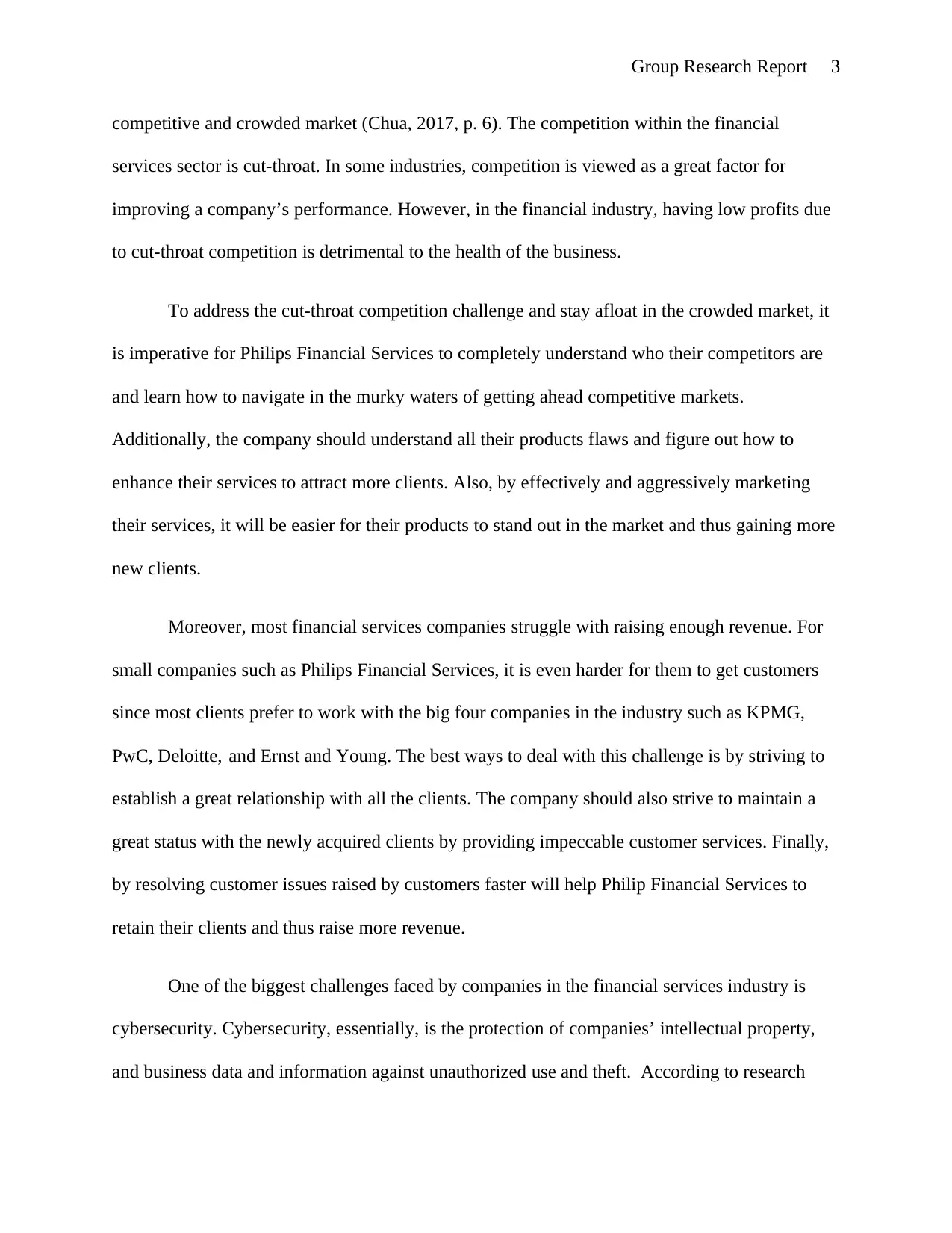
Group Research Report 3
competitive and crowded market (Chua, 2017, p. 6). The competition within the financial
services sector is cut-throat. In some industries, competition is viewed as a great factor for
improving a company’s performance. However, in the financial industry, having low profits due
to cut-throat competition is detrimental to the health of the business.
To address the cut-throat competition challenge and stay afloat in the crowded market, it
is imperative for Philips Financial Services to completely understand who their competitors are
and learn how to navigate in the murky waters of getting ahead competitive markets.
Additionally, the company should understand all their products flaws and figure out how to
enhance their services to attract more clients. Also, by effectively and aggressively marketing
their services, it will be easier for their products to stand out in the market and thus gaining more
new clients.
Moreover, most financial services companies struggle with raising enough revenue. For
small companies such as Philips Financial Services, it is even harder for them to get customers
since most clients prefer to work with the big four companies in the industry such as KPMG,
PwC, Deloitte, and Ernst and Young. The best ways to deal with this challenge is by striving to
establish a great relationship with all the clients. The company should also strive to maintain a
great status with the newly acquired clients by providing impeccable customer services. Finally,
by resolving customer issues raised by customers faster will help Philip Financial Services to
retain their clients and thus raise more revenue.
One of the biggest challenges faced by companies in the financial services industry is
cybersecurity. Cybersecurity, essentially, is the protection of companies’ intellectual property,
and business data and information against unauthorized use and theft. According to research
competitive and crowded market (Chua, 2017, p. 6). The competition within the financial
services sector is cut-throat. In some industries, competition is viewed as a great factor for
improving a company’s performance. However, in the financial industry, having low profits due
to cut-throat competition is detrimental to the health of the business.
To address the cut-throat competition challenge and stay afloat in the crowded market, it
is imperative for Philips Financial Services to completely understand who their competitors are
and learn how to navigate in the murky waters of getting ahead competitive markets.
Additionally, the company should understand all their products flaws and figure out how to
enhance their services to attract more clients. Also, by effectively and aggressively marketing
their services, it will be easier for their products to stand out in the market and thus gaining more
new clients.
Moreover, most financial services companies struggle with raising enough revenue. For
small companies such as Philips Financial Services, it is even harder for them to get customers
since most clients prefer to work with the big four companies in the industry such as KPMG,
PwC, Deloitte, and Ernst and Young. The best ways to deal with this challenge is by striving to
establish a great relationship with all the clients. The company should also strive to maintain a
great status with the newly acquired clients by providing impeccable customer services. Finally,
by resolving customer issues raised by customers faster will help Philip Financial Services to
retain their clients and thus raise more revenue.
One of the biggest challenges faced by companies in the financial services industry is
cybersecurity. Cybersecurity, essentially, is the protection of companies’ intellectual property,
and business data and information against unauthorized use and theft. According to research
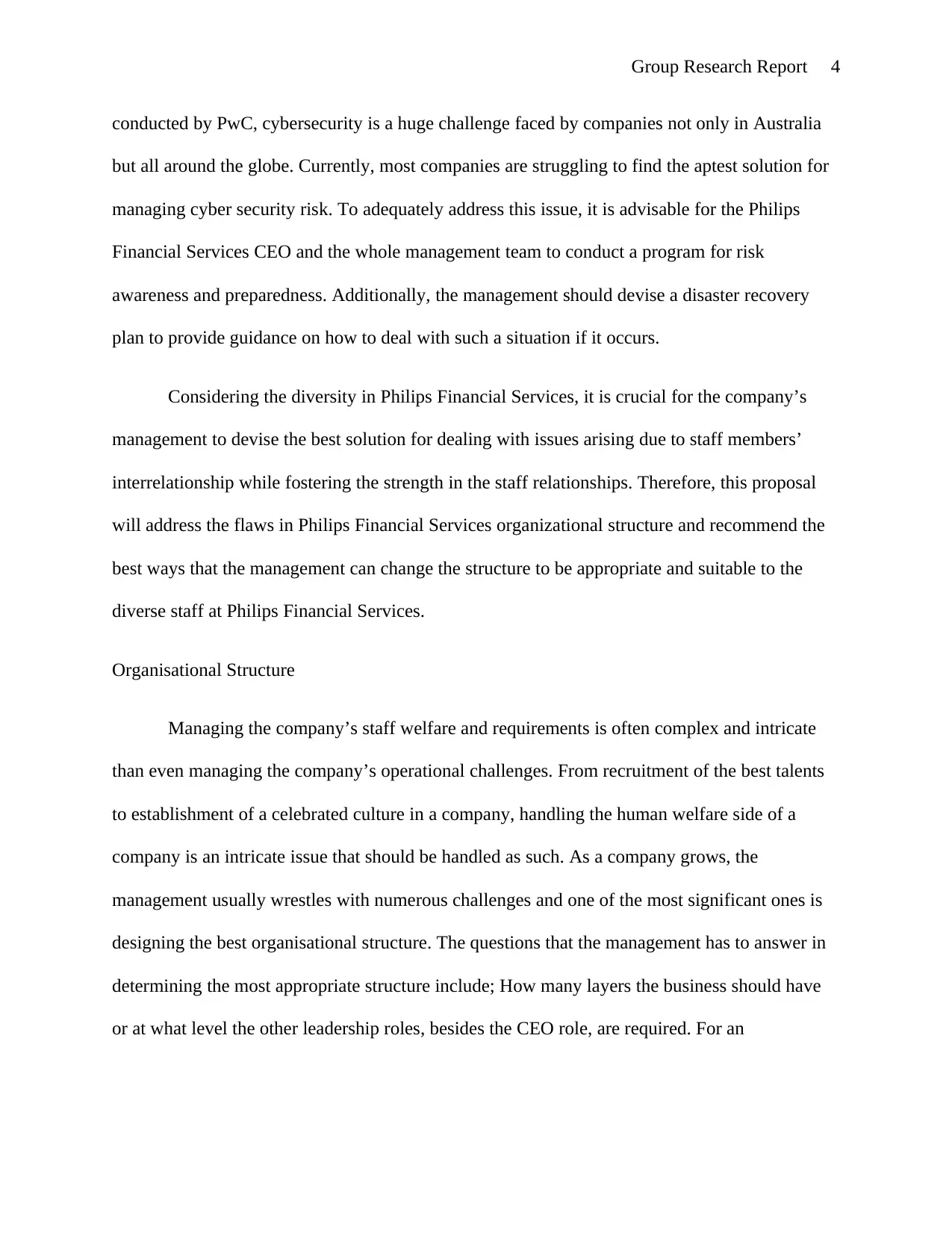
Group Research Report 4
conducted by PwC, cybersecurity is a huge challenge faced by companies not only in Australia
but all around the globe. Currently, most companies are struggling to find the aptest solution for
managing cyber security risk. To adequately address this issue, it is advisable for the Philips
Financial Services CEO and the whole management team to conduct a program for risk
awareness and preparedness. Additionally, the management should devise a disaster recovery
plan to provide guidance on how to deal with such a situation if it occurs.
Considering the diversity in Philips Financial Services, it is crucial for the company’s
management to devise the best solution for dealing with issues arising due to staff members’
interrelationship while fostering the strength in the staff relationships. Therefore, this proposal
will address the flaws in Philips Financial Services organizational structure and recommend the
best ways that the management can change the structure to be appropriate and suitable to the
diverse staff at Philips Financial Services.
Organisational Structure
Managing the company’s staff welfare and requirements is often complex and intricate
than even managing the company’s operational challenges. From recruitment of the best talents
to establishment of a celebrated culture in a company, handling the human welfare side of a
company is an intricate issue that should be handled as such. As a company grows, the
management usually wrestles with numerous challenges and one of the most significant ones is
designing the best organisational structure. The questions that the management has to answer in
determining the most appropriate structure include; How many layers the business should have
or at what level the other leadership roles, besides the CEO role, are required. For an
conducted by PwC, cybersecurity is a huge challenge faced by companies not only in Australia
but all around the globe. Currently, most companies are struggling to find the aptest solution for
managing cyber security risk. To adequately address this issue, it is advisable for the Philips
Financial Services CEO and the whole management team to conduct a program for risk
awareness and preparedness. Additionally, the management should devise a disaster recovery
plan to provide guidance on how to deal with such a situation if it occurs.
Considering the diversity in Philips Financial Services, it is crucial for the company’s
management to devise the best solution for dealing with issues arising due to staff members’
interrelationship while fostering the strength in the staff relationships. Therefore, this proposal
will address the flaws in Philips Financial Services organizational structure and recommend the
best ways that the management can change the structure to be appropriate and suitable to the
diverse staff at Philips Financial Services.
Organisational Structure
Managing the company’s staff welfare and requirements is often complex and intricate
than even managing the company’s operational challenges. From recruitment of the best talents
to establishment of a celebrated culture in a company, handling the human welfare side of a
company is an intricate issue that should be handled as such. As a company grows, the
management usually wrestles with numerous challenges and one of the most significant ones is
designing the best organisational structure. The questions that the management has to answer in
determining the most appropriate structure include; How many layers the business should have
or at what level the other leadership roles, besides the CEO role, are required. For an
Secure Best Marks with AI Grader
Need help grading? Try our AI Grader for instant feedback on your assignments.
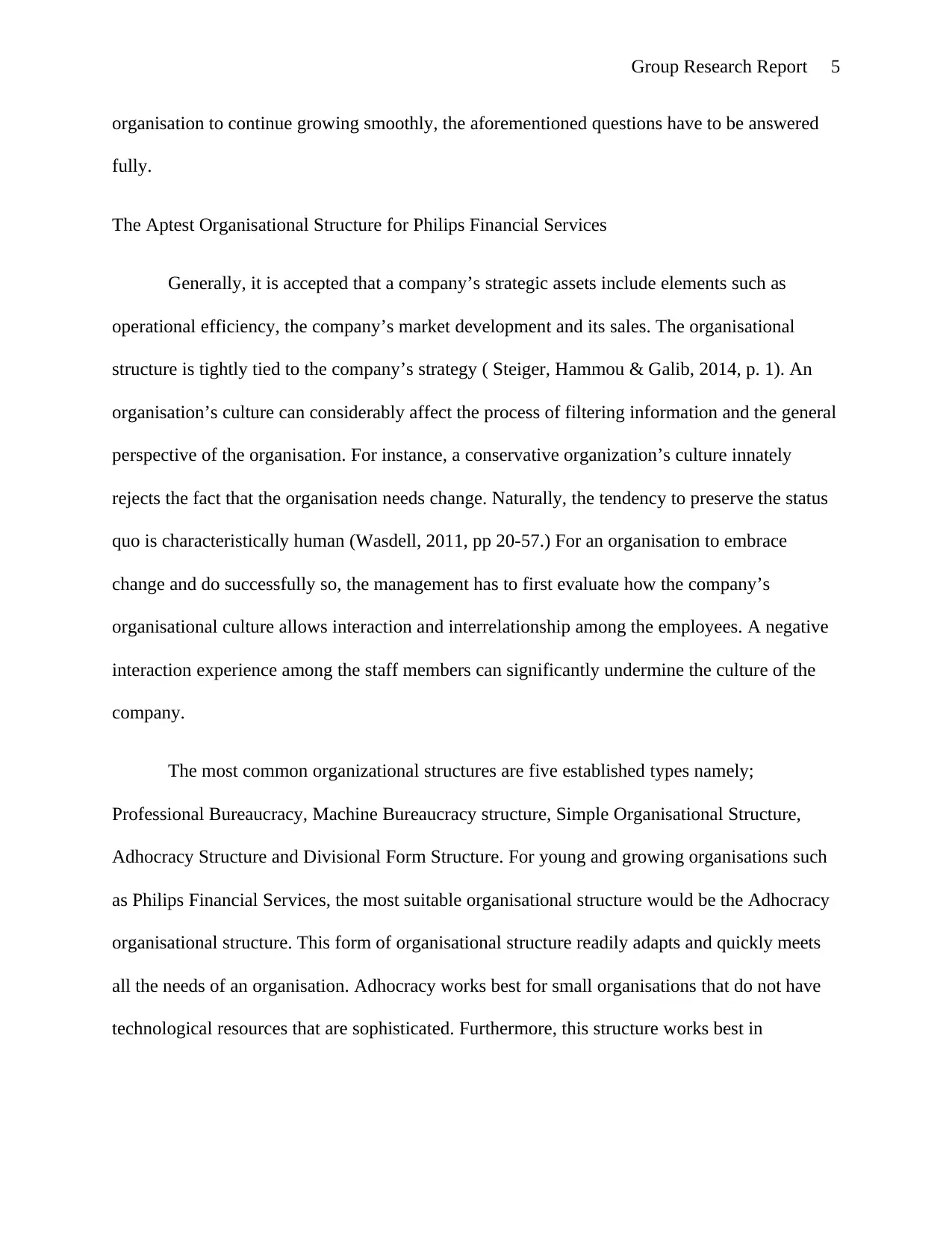
Group Research Report 5
organisation to continue growing smoothly, the aforementioned questions have to be answered
fully.
The Aptest Organisational Structure for Philips Financial Services
Generally, it is accepted that a company’s strategic assets include elements such as
operational efficiency, the company’s market development and its sales. The organisational
structure is tightly tied to the company’s strategy ( Steiger, Hammou & Galib, 2014, p. 1). An
organisation’s culture can considerably affect the process of filtering information and the general
perspective of the organisation. For instance, a conservative organization’s culture innately
rejects the fact that the organisation needs change. Naturally, the tendency to preserve the status
quo is characteristically human (Wasdell, 2011, pp 20-57.) For an organisation to embrace
change and do successfully so, the management has to first evaluate how the company’s
organisational culture allows interaction and interrelationship among the employees. A negative
interaction experience among the staff members can significantly undermine the culture of the
company.
The most common organizational structures are five established types namely;
Professional Bureaucracy, Machine Bureaucracy structure, Simple Organisational Structure,
Adhocracy Structure and Divisional Form Structure. For young and growing organisations such
as Philips Financial Services, the most suitable organisational structure would be the Adhocracy
organisational structure. This form of organisational structure readily adapts and quickly meets
all the needs of an organisation. Adhocracy works best for small organisations that do not have
technological resources that are sophisticated. Furthermore, this structure works best in
organisation to continue growing smoothly, the aforementioned questions have to be answered
fully.
The Aptest Organisational Structure for Philips Financial Services
Generally, it is accepted that a company’s strategic assets include elements such as
operational efficiency, the company’s market development and its sales. The organisational
structure is tightly tied to the company’s strategy ( Steiger, Hammou & Galib, 2014, p. 1). An
organisation’s culture can considerably affect the process of filtering information and the general
perspective of the organisation. For instance, a conservative organization’s culture innately
rejects the fact that the organisation needs change. Naturally, the tendency to preserve the status
quo is characteristically human (Wasdell, 2011, pp 20-57.) For an organisation to embrace
change and do successfully so, the management has to first evaluate how the company’s
organisational culture allows interaction and interrelationship among the employees. A negative
interaction experience among the staff members can significantly undermine the culture of the
company.
The most common organizational structures are five established types namely;
Professional Bureaucracy, Machine Bureaucracy structure, Simple Organisational Structure,
Adhocracy Structure and Divisional Form Structure. For young and growing organisations such
as Philips Financial Services, the most suitable organisational structure would be the Adhocracy
organisational structure. This form of organisational structure readily adapts and quickly meets
all the needs of an organisation. Adhocracy works best for small organisations that do not have
technological resources that are sophisticated. Furthermore, this structure works best in
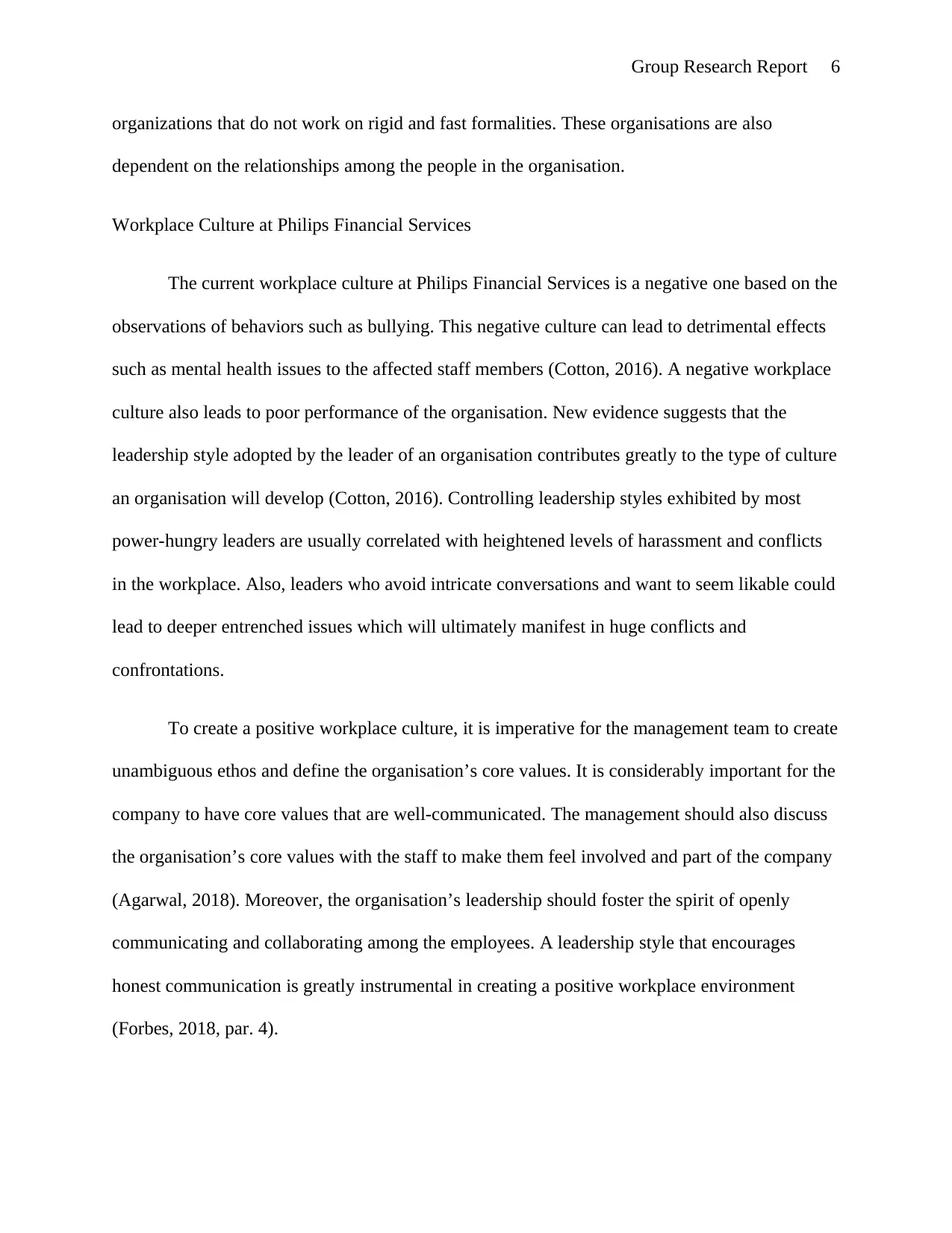
Group Research Report 6
organizations that do not work on rigid and fast formalities. These organisations are also
dependent on the relationships among the people in the organisation.
Workplace Culture at Philips Financial Services
The current workplace culture at Philips Financial Services is a negative one based on the
observations of behaviors such as bullying. This negative culture can lead to detrimental effects
such as mental health issues to the affected staff members (Cotton, 2016). A negative workplace
culture also leads to poor performance of the organisation. New evidence suggests that the
leadership style adopted by the leader of an organisation contributes greatly to the type of culture
an organisation will develop (Cotton, 2016). Controlling leadership styles exhibited by most
power-hungry leaders are usually correlated with heightened levels of harassment and conflicts
in the workplace. Also, leaders who avoid intricate conversations and want to seem likable could
lead to deeper entrenched issues which will ultimately manifest in huge conflicts and
confrontations.
To create a positive workplace culture, it is imperative for the management team to create
unambiguous ethos and define the organisation’s core values. It is considerably important for the
company to have core values that are well-communicated. The management should also discuss
the organisation’s core values with the staff to make them feel involved and part of the company
(Agarwal, 2018). Moreover, the organisation’s leadership should foster the spirit of openly
communicating and collaborating among the employees. A leadership style that encourages
honest communication is greatly instrumental in creating a positive workplace environment
(Forbes, 2018, par. 4).
organizations that do not work on rigid and fast formalities. These organisations are also
dependent on the relationships among the people in the organisation.
Workplace Culture at Philips Financial Services
The current workplace culture at Philips Financial Services is a negative one based on the
observations of behaviors such as bullying. This negative culture can lead to detrimental effects
such as mental health issues to the affected staff members (Cotton, 2016). A negative workplace
culture also leads to poor performance of the organisation. New evidence suggests that the
leadership style adopted by the leader of an organisation contributes greatly to the type of culture
an organisation will develop (Cotton, 2016). Controlling leadership styles exhibited by most
power-hungry leaders are usually correlated with heightened levels of harassment and conflicts
in the workplace. Also, leaders who avoid intricate conversations and want to seem likable could
lead to deeper entrenched issues which will ultimately manifest in huge conflicts and
confrontations.
To create a positive workplace culture, it is imperative for the management team to create
unambiguous ethos and define the organisation’s core values. It is considerably important for the
company to have core values that are well-communicated. The management should also discuss
the organisation’s core values with the staff to make them feel involved and part of the company
(Agarwal, 2018). Moreover, the organisation’s leadership should foster the spirit of openly
communicating and collaborating among the employees. A leadership style that encourages
honest communication is greatly instrumental in creating a positive workplace environment
(Forbes, 2018, par. 4).
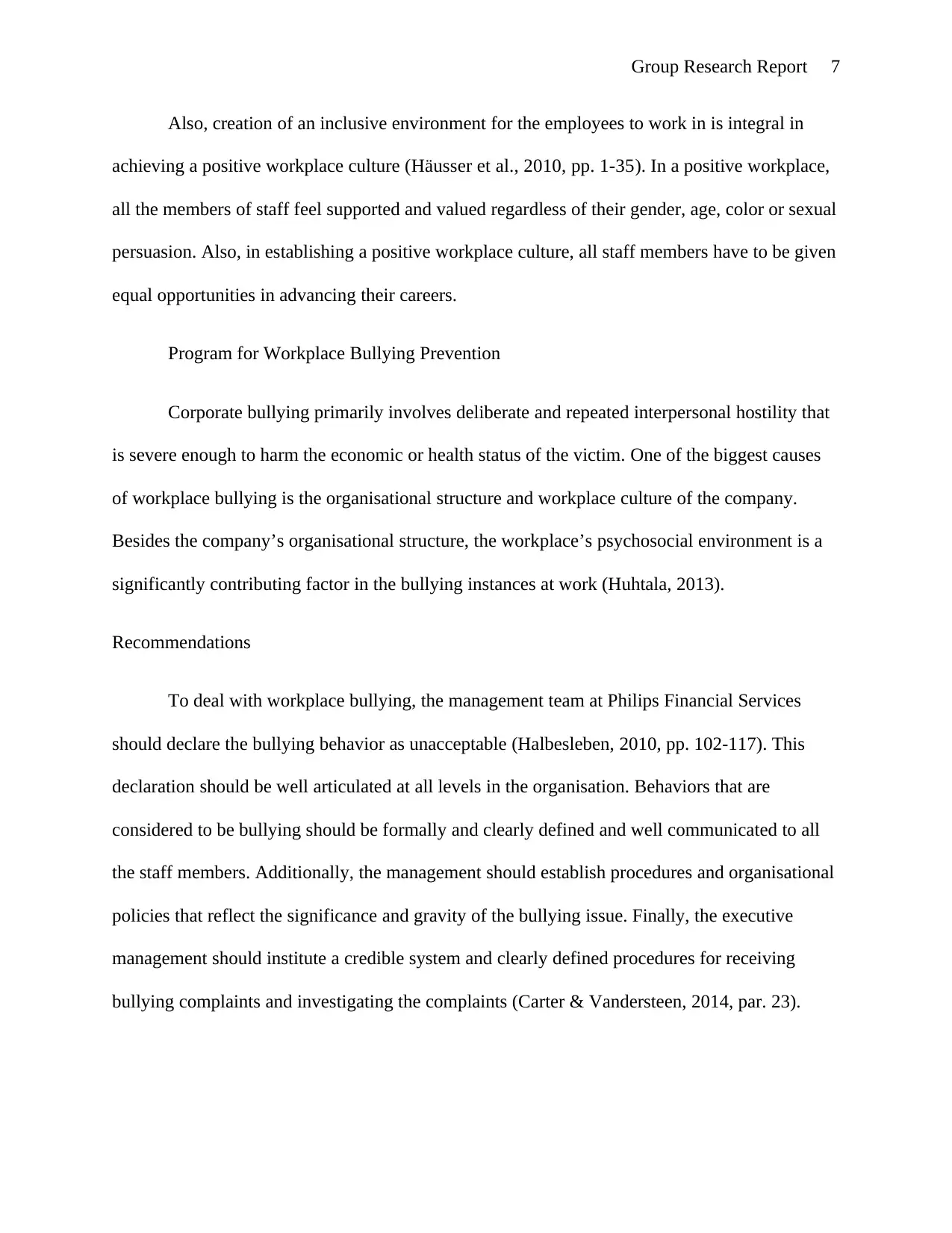
Group Research Report 7
Also, creation of an inclusive environment for the employees to work in is integral in
achieving a positive workplace culture (Häusser et al., 2010, pp. 1-35). In a positive workplace,
all the members of staff feel supported and valued regardless of their gender, age, color or sexual
persuasion. Also, in establishing a positive workplace culture, all staff members have to be given
equal opportunities in advancing their careers.
Program for Workplace Bullying Prevention
Corporate bullying primarily involves deliberate and repeated interpersonal hostility that
is severe enough to harm the economic or health status of the victim. One of the biggest causes
of workplace bullying is the organisational structure and workplace culture of the company.
Besides the company’s organisational structure, the workplace’s psychosocial environment is a
significantly contributing factor in the bullying instances at work (Huhtala, 2013).
Recommendations
To deal with workplace bullying, the management team at Philips Financial Services
should declare the bullying behavior as unacceptable (Halbesleben, 2010, pp. 102-117). This
declaration should be well articulated at all levels in the organisation. Behaviors that are
considered to be bullying should be formally and clearly defined and well communicated to all
the staff members. Additionally, the management should establish procedures and organisational
policies that reflect the significance and gravity of the bullying issue. Finally, the executive
management should institute a credible system and clearly defined procedures for receiving
bullying complaints and investigating the complaints (Carter & Vandersteen, 2014, par. 23).
Also, creation of an inclusive environment for the employees to work in is integral in
achieving a positive workplace culture (Häusser et al., 2010, pp. 1-35). In a positive workplace,
all the members of staff feel supported and valued regardless of their gender, age, color or sexual
persuasion. Also, in establishing a positive workplace culture, all staff members have to be given
equal opportunities in advancing their careers.
Program for Workplace Bullying Prevention
Corporate bullying primarily involves deliberate and repeated interpersonal hostility that
is severe enough to harm the economic or health status of the victim. One of the biggest causes
of workplace bullying is the organisational structure and workplace culture of the company.
Besides the company’s organisational structure, the workplace’s psychosocial environment is a
significantly contributing factor in the bullying instances at work (Huhtala, 2013).
Recommendations
To deal with workplace bullying, the management team at Philips Financial Services
should declare the bullying behavior as unacceptable (Halbesleben, 2010, pp. 102-117). This
declaration should be well articulated at all levels in the organisation. Behaviors that are
considered to be bullying should be formally and clearly defined and well communicated to all
the staff members. Additionally, the management should establish procedures and organisational
policies that reflect the significance and gravity of the bullying issue. Finally, the executive
management should institute a credible system and clearly defined procedures for receiving
bullying complaints and investigating the complaints (Carter & Vandersteen, 2014, par. 23).
Paraphrase This Document
Need a fresh take? Get an instant paraphrase of this document with our AI Paraphraser
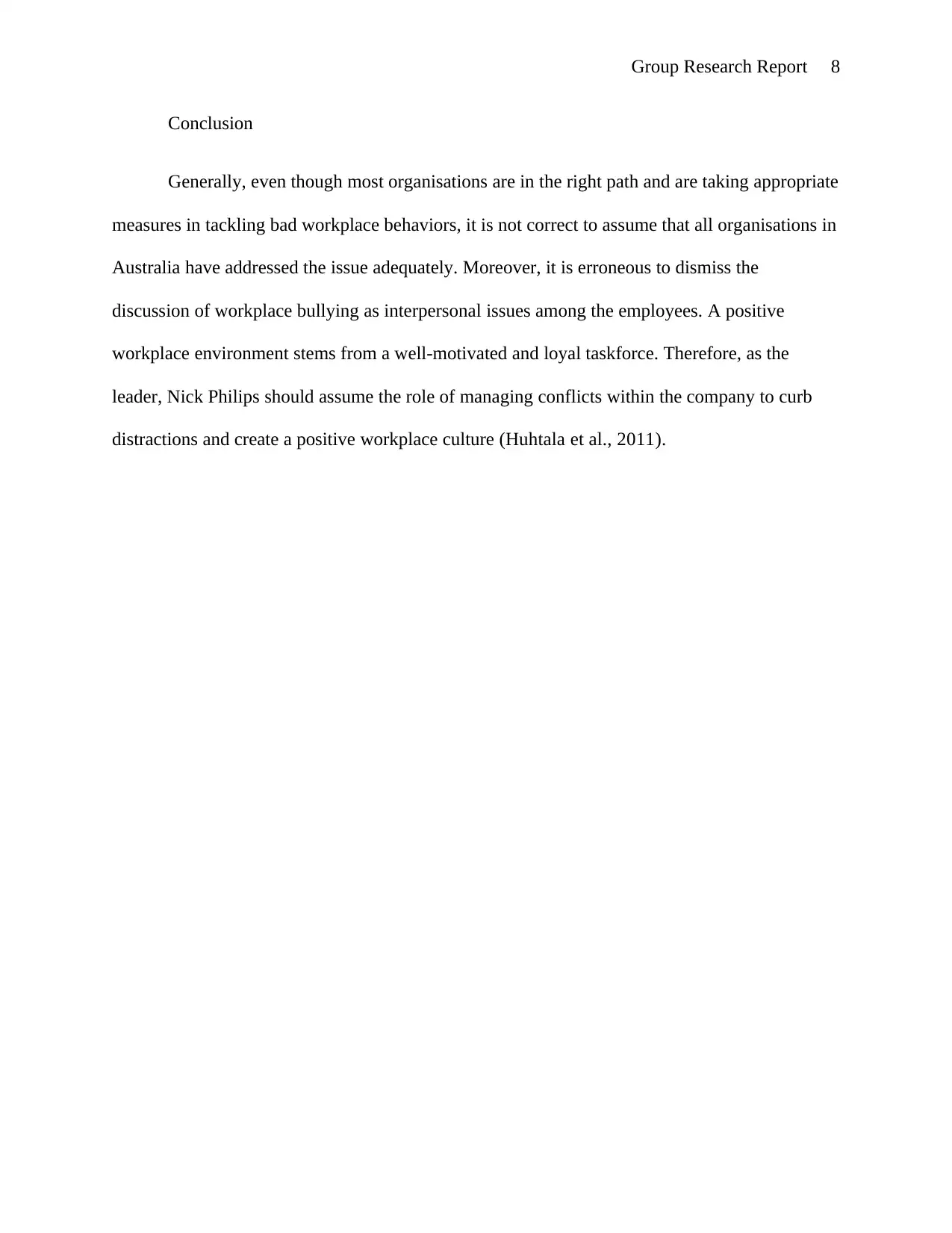
Group Research Report 8
Conclusion
Generally, even though most organisations are in the right path and are taking appropriate
measures in tackling bad workplace behaviors, it is not correct to assume that all organisations in
Australia have addressed the issue adequately. Moreover, it is erroneous to dismiss the
discussion of workplace bullying as interpersonal issues among the employees. A positive
workplace environment stems from a well-motivated and loyal taskforce. Therefore, as the
leader, Nick Philips should assume the role of managing conflicts within the company to curb
distractions and create a positive workplace culture (Huhtala et al., 2011).
Conclusion
Generally, even though most organisations are in the right path and are taking appropriate
measures in tackling bad workplace behaviors, it is not correct to assume that all organisations in
Australia have addressed the issue adequately. Moreover, it is erroneous to dismiss the
discussion of workplace bullying as interpersonal issues among the employees. A positive
workplace environment stems from a well-motivated and loyal taskforce. Therefore, as the
leader, Nick Philips should assume the role of managing conflicts within the company to curb
distractions and create a positive workplace culture (Huhtala et al., 2011).
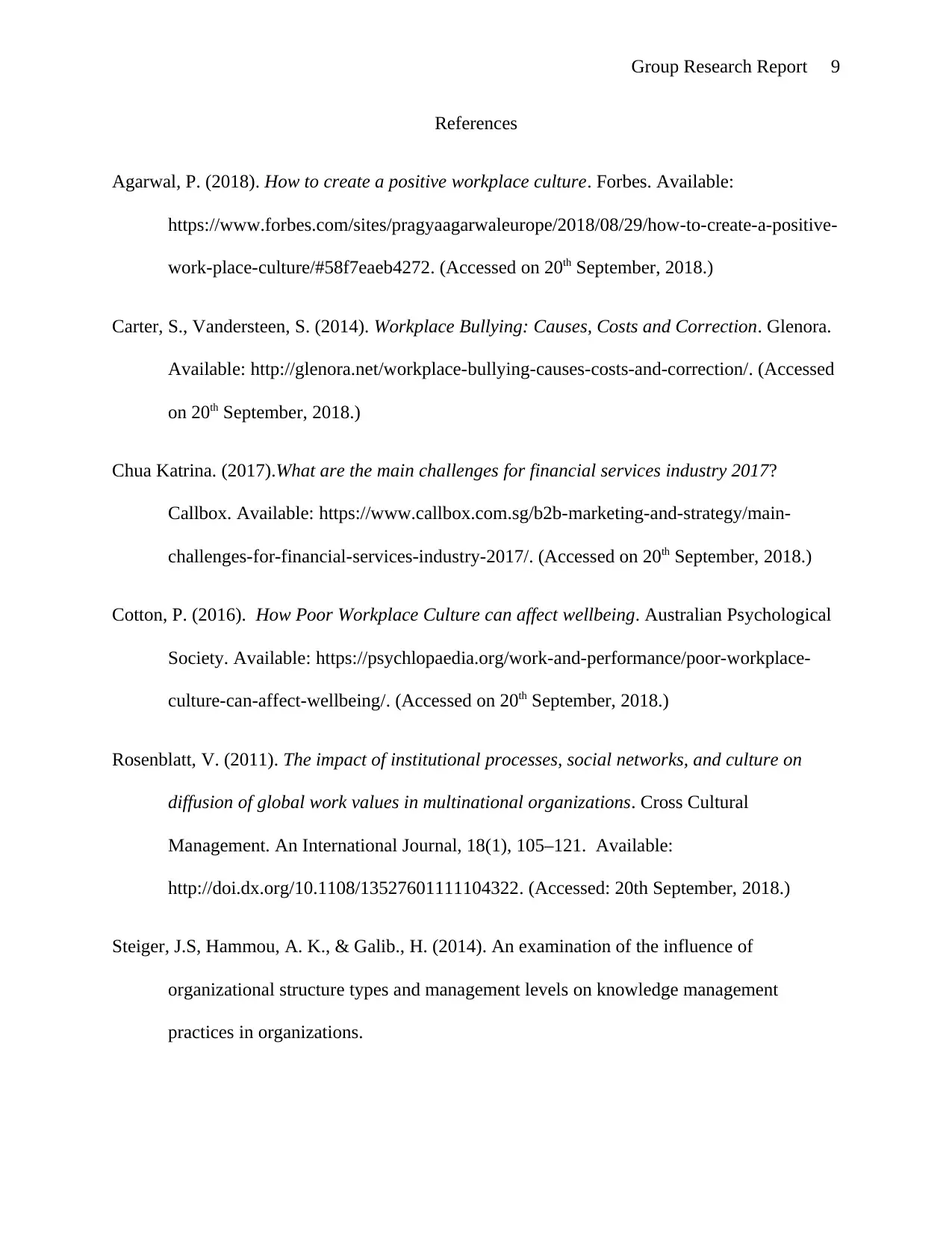
Group Research Report 9
References
Agarwal, P. (2018). How to create a positive workplace culture. Forbes. Available:
https://www.forbes.com/sites/pragyaagarwaleurope/2018/08/29/how-to-create-a-positive-
work-place-culture/#58f7eaeb4272. (Accessed on 20th September, 2018.)
Carter, S., Vandersteen, S. (2014). Workplace Bullying: Causes, Costs and Correction. Glenora.
Available: http://glenora.net/workplace-bullying-causes-costs-and-correction/. (Accessed
on 20th September, 2018.)
Chua Katrina. (2017).What are the main challenges for financial services industry 2017?
Callbox. Available: https://www.callbox.com.sg/b2b-marketing-and-strategy/main-
challenges-for-financial-services-industry-2017/. (Accessed on 20th September, 2018.)
Cotton, P. (2016). How Poor Workplace Culture can affect wellbeing. Australian Psychological
Society. Available: https://psychlopaedia.org/work-and-performance/poor-workplace-
culture-can-affect-wellbeing/. (Accessed on 20th September, 2018.)
Rosenblatt, V. (2011). The impact of institutional processes, social networks, and culture on
diffusion of global work values in multinational organizations. Cross Cultural
Management. An International Journal, 18(1), 105–121. Available:
http://doi.dx.org/10.1108/13527601111104322. (Accessed: 20th September, 2018.)
Steiger, J.S, Hammou, A. K., & Galib., H. (2014). An examination of the influence of
organizational structure types and management levels on knowledge management
practices in organizations.
References
Agarwal, P. (2018). How to create a positive workplace culture. Forbes. Available:
https://www.forbes.com/sites/pragyaagarwaleurope/2018/08/29/how-to-create-a-positive-
work-place-culture/#58f7eaeb4272. (Accessed on 20th September, 2018.)
Carter, S., Vandersteen, S. (2014). Workplace Bullying: Causes, Costs and Correction. Glenora.
Available: http://glenora.net/workplace-bullying-causes-costs-and-correction/. (Accessed
on 20th September, 2018.)
Chua Katrina. (2017).What are the main challenges for financial services industry 2017?
Callbox. Available: https://www.callbox.com.sg/b2b-marketing-and-strategy/main-
challenges-for-financial-services-industry-2017/. (Accessed on 20th September, 2018.)
Cotton, P. (2016). How Poor Workplace Culture can affect wellbeing. Australian Psychological
Society. Available: https://psychlopaedia.org/work-and-performance/poor-workplace-
culture-can-affect-wellbeing/. (Accessed on 20th September, 2018.)
Rosenblatt, V. (2011). The impact of institutional processes, social networks, and culture on
diffusion of global work values in multinational organizations. Cross Cultural
Management. An International Journal, 18(1), 105–121. Available:
http://doi.dx.org/10.1108/13527601111104322. (Accessed: 20th September, 2018.)
Steiger, J.S, Hammou, A. K., & Galib., H. (2014). An examination of the influence of
organizational structure types and management levels on knowledge management
practices in organizations.
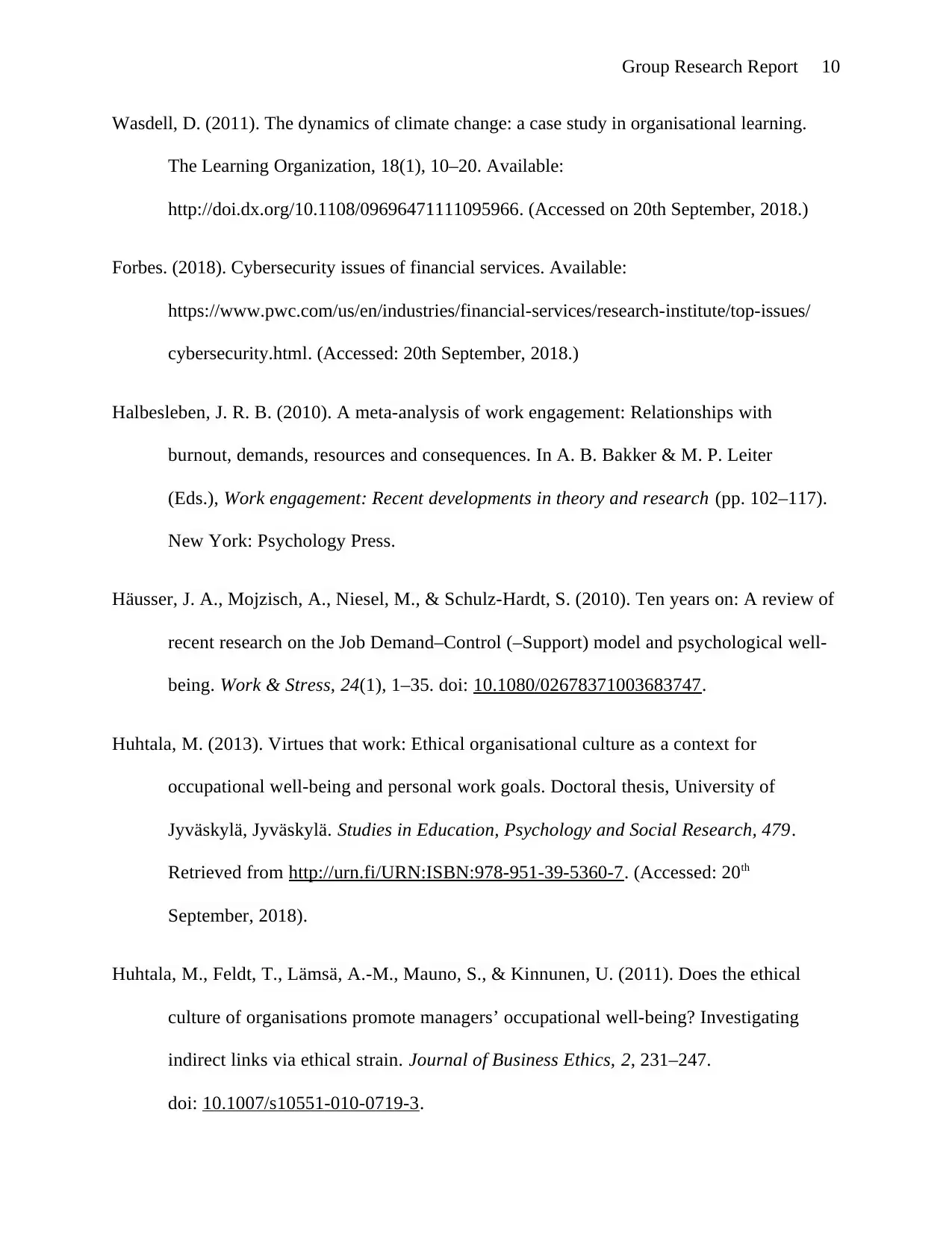
Group Research Report 10
Wasdell, D. (2011). The dynamics of climate change: a case study in organisational learning.
The Learning Organization, 18(1), 10–20. Available:
http://doi.dx.org/10.1108/09696471111095966. (Accessed on 20th September, 2018.)
Forbes. (2018). Cybersecurity issues of financial services. Available:
https://www.pwc.com/us/en/industries/financial-services/research-institute/top-issues/
cybersecurity.html. (Accessed: 20th September, 2018.)
Halbesleben, J. R. B. (2010). A meta-analysis of work engagement: Relationships with
burnout, demands, resources and consequences. In A. B. Bakker & M. P. Leiter
(Eds.), Work engagement: Recent developments in theory and research (pp. 102–117).
New York: Psychology Press.
Häusser, J. A., Mojzisch, A., Niesel, M., & Schulz-Hardt, S. (2010). Ten years on: A review of
recent research on the Job Demand–Control (–Support) model and psychological well-
being. Work & Stress, 24(1), 1–35. doi: 10.1080/02678371003683747.
Huhtala, M. (2013). Virtues that work: Ethical organisational culture as a context for
occupational well-being and personal work goals. Doctoral thesis, University of
Jyväskylä, Jyväskylä. Studies in Education, Psychology and Social Research, 479.
Retrieved from http://urn.fi/URN:ISBN:978-951-39-5360-7. (Accessed: 20th
September, 2018).
Huhtala, M., Feldt, T., Lämsä, A.-M., Mauno, S., & Kinnunen, U. (2011). Does the ethical
culture of organisations promote managers’ occupational well-being? Investigating
indirect links via ethical strain. Journal of Business Ethics, 2, 231–247.
doi: 10.1007/s10551-010-0719-3.
Wasdell, D. (2011). The dynamics of climate change: a case study in organisational learning.
The Learning Organization, 18(1), 10–20. Available:
http://doi.dx.org/10.1108/09696471111095966. (Accessed on 20th September, 2018.)
Forbes. (2018). Cybersecurity issues of financial services. Available:
https://www.pwc.com/us/en/industries/financial-services/research-institute/top-issues/
cybersecurity.html. (Accessed: 20th September, 2018.)
Halbesleben, J. R. B. (2010). A meta-analysis of work engagement: Relationships with
burnout, demands, resources and consequences. In A. B. Bakker & M. P. Leiter
(Eds.), Work engagement: Recent developments in theory and research (pp. 102–117).
New York: Psychology Press.
Häusser, J. A., Mojzisch, A., Niesel, M., & Schulz-Hardt, S. (2010). Ten years on: A review of
recent research on the Job Demand–Control (–Support) model and psychological well-
being. Work & Stress, 24(1), 1–35. doi: 10.1080/02678371003683747.
Huhtala, M. (2013). Virtues that work: Ethical organisational culture as a context for
occupational well-being and personal work goals. Doctoral thesis, University of
Jyväskylä, Jyväskylä. Studies in Education, Psychology and Social Research, 479.
Retrieved from http://urn.fi/URN:ISBN:978-951-39-5360-7. (Accessed: 20th
September, 2018).
Huhtala, M., Feldt, T., Lämsä, A.-M., Mauno, S., & Kinnunen, U. (2011). Does the ethical
culture of organisations promote managers’ occupational well-being? Investigating
indirect links via ethical strain. Journal of Business Ethics, 2, 231–247.
doi: 10.1007/s10551-010-0719-3.
Secure Best Marks with AI Grader
Need help grading? Try our AI Grader for instant feedback on your assignments.
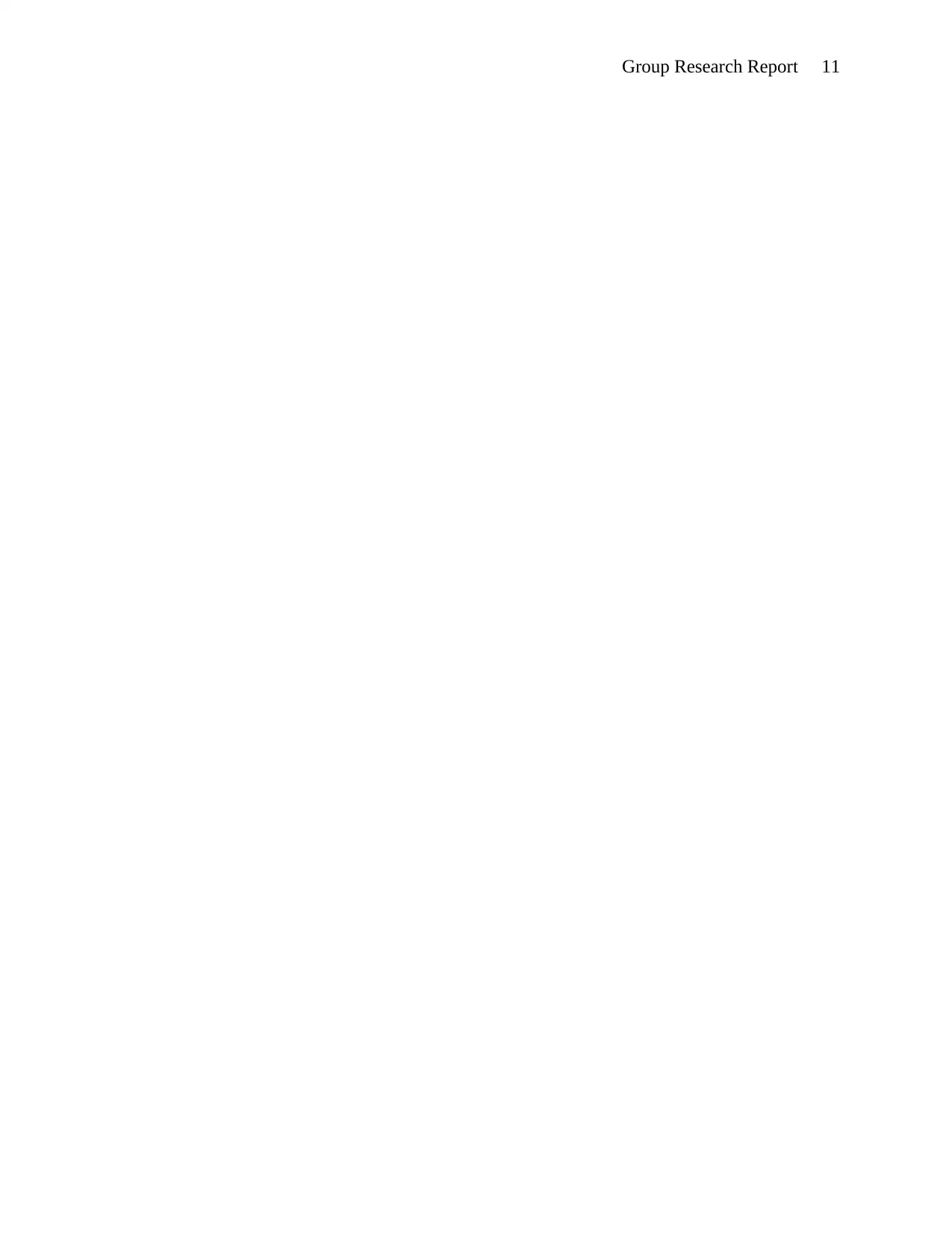
Group Research Report 11
1 out of 11
Related Documents
Your All-in-One AI-Powered Toolkit for Academic Success.
+13062052269
info@desklib.com
Available 24*7 on WhatsApp / Email
![[object Object]](/_next/static/media/star-bottom.7253800d.svg)
Unlock your academic potential
© 2024 | Zucol Services PVT LTD | All rights reserved.





